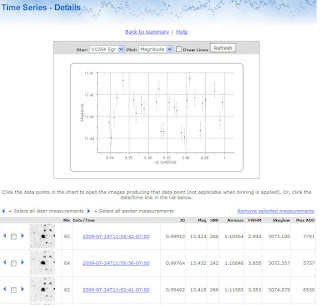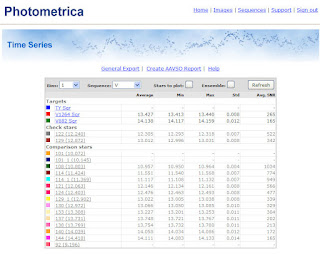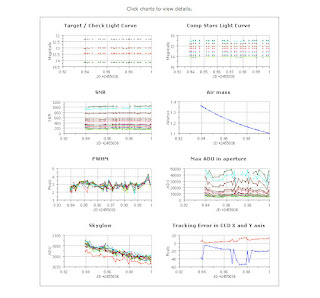Weather can have an impact on an observing campaign, so there have been some challenges in obtaining some of the data I have been chasing this week. I am getting great positive feedback on the blog - largely because I am blogging on my observations.
So this week, given the weather, I thought it would be good to talk about observation campaigns. This week I have barely jagged a couple of short sessions on
V4743 SGR and some of the surrounding variables in the same field. V4743 Sgr is also referred to as Nova Sgr 2002c making it an object of some interest, given its nova outburst in 2002. Over 200 observers have contributed to the AAVSOs lightcurve.

So what is it that makes an object "interesting"? Clearly a Nova outburst is something that is interesting, as professional astronomers are quick to follow up with highly accurate spectroscopy. The advantage of having amateurs "on their toes" and participating in regular campaigns is that professional astronomers can't afford to have billion dollar telescopes pointed at stars, waiting for years, for something to happen. (The hubble deep field shot is a noteable exception...but a deliberate experiment to look at nothing to see if something WAS there)
A good example of leveraging the skills of amateur astronomers is my data here on QU Sgr. This is a Mira variable star of little or no interest to anyone.....but who knows one day it may be significant or do something. If that ever happened, what would we have to compare it with? So whilst gathering some data on V4743 with my set up which has a fairly large field of view, it is important to grab a couple of readings on any other Variables in the field, as other observers are unlikely to ever go specifically to QU Sgr to collect data.

There are a plethora of variable stars requiring regular observations and a limited number of observers. Today we have the fantastic use of social networking, blogs, forums and membership of organisations such as AAVSO. In this environment connected communities of dedicated amateurs have organised campaigns based on a prioritised list of "interesting objects".
Rod Stubbing who discovered this months outburst of VX For was working through a carefully targeted list of variables that were "in season" ie at an optimal position in the sky for observing. Rod indicated to me it was his first observing session on VX For for the year. So you never know what you will find, and how many other people who are observing.

So I leave you this week with the completely insignificant Mira Variable QU Sgr that noone else has reported on for over 4000 days.










